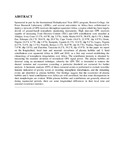GPS Observations of Plasma Bubbles and Scintillations over Equatorial Africa

View/
Date
2010-12Author
Carrano, C S
Valladares, C E
Semala, G K
Bridgwood, C T
Adeniyi, J
Amaeshi, L. L.
D'Ujanga, F Mutonyi
Ndeda, J. D
.Baki, P
Obrou, O K.
Okere, B
Okere, B
Tsidu, G M.
Type
PresentationLanguage
enMetadata
Show full item recordAbstract
Sponsored in part by the International Heliophysical Year (IHY) program, Boston College, Air Force Research Laboratory (AFRL), and several universities in Africa have collaborated to deploy a network of GPS receivers throughout equatorial Africa, a region which has been largely devoid of ground-based ionospheric monitoring instruments. High date-rate GPS receivers capable of measuring Total Electron Content (TEC) and GPS scintillations were installed at Abidjan, Ivory Coast (5.3°N, 4.0°W, dip 3.5°S); Addis Ababa (9.0°N, 38.8°E, dip 0.1°N ); Bahir Dar, Ethiopia (26.1°N, 50.6°E, dip 20.1°N); Cape Verde (16.6°S, 22.9°W, dip 4.9°N); Ilorin, Nigeria (8.4°S, 4.7°E, dip 1.9°S); Kampala, Uganda (0.3°S, 32.6°E, dip 9.2°S); Lagos, Nigeria (6.5°N, 3.4°E, dip 3.1°S); Nairobi, Kenya (1.3°S, 36.8°W, dip 10.7°S); Nsukka, Nigeria (6.8°S, 7.4°W, dip 3.0°S); and Zanzibar, Tanzania (6.2°S, 39.2°E, dip 15.9°S). In this paper we report on the longitudinal, local time and seasonal occurrence of plasma bubbles and L band scintillations over equatorial Africa in 2009 and 2010, as a first step toward establishing the climatology of ionospheric irregularities over Africa. The scintillation intensity is obtained by measuring the standard deviation of normalized GPS signal power. The plasma bubbles are detected using an automated technique, whereby the GPS TEC is detrended to remove the diurnal variation and excursions exceeding a particular threshold are extracted for further analysis. A harmonic analysis (FFT) of these extracted events is performed to exclude wavelike features indicative of gravity waves or traveling ionospheric disturbances, and the remaining events are identified as plasma bubbles. Our findings suggest that the occurrence of plasma bubbles and L band scintillations over Africa are well correlated, but that some discrepancies in their morphologies are evident. While plasma bubbles and scintillations are generally observed during equinoctial periods, there are some longitudinal differences in their local time and seasonal occurrence statistics.
Citation
American Geophysical Union, Fall Meeting 2010, abstract #SA43C-06Publisher
University of Nairobi
